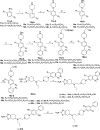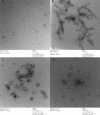Multifunctional D2/D3 agonist D-520 with high in vivo efficacy: modulator of toxicity of alpha-synuclein aggregates
- PMID: 24960209
- PMCID: PMC4140597
- DOI: 10.1021/cn500084x
Multifunctional D2/D3 agonist D-520 with high in vivo efficacy: modulator of toxicity of alpha-synuclein aggregates
Abstract
We have developed a series of dihydroxy compounds and related analogues based on our hybrid D2/D3 agonist molecular template to develop multifunctional drugs for symptomatic and neuroprotective treatment for Parkinson's disease (PD). The lead compound (-)-24b (D-520) exhibited high agonist potency at D2/D3 receptors and produced efficacious activity in the animal models for PD. The data from thioflavin T (ThT) assay and from transmission electron microscopy (TEM) analysis demonstrate that D-520 is able to modulate aggregation of alpha-synuclein (αSN). Additionally, coincubation of D-520 with αSN is able to reduce toxicity of preformed aggregates of αSN compared to control αSN alone. Finally, in a neuroprotection study with dopaminergic MN9D cells, D-520 clearly demonstrated the effect of neuroprotection from toxicity of 6-hydroxydopamine. Thus, compound D-520 possesses properties characteristic of multifunctionality conducive to symptomatic and neuroprotective treatment of PD.
Figures











Similar articles
-
A novel iron (II) preferring dopamine agonist chelator D-607 significantly suppresses α-syn- and MPTP-induced toxicities in vivo.Neuropharmacology. 2017 Sep 1;123:88-99. doi: 10.1016/j.neuropharm.2017.05.019. Epub 2017 May 19. Neuropharmacology. 2017. PMID: 28533164 Free PMC article.
-
Novel multifunctional dopamine D2/D3 receptors agonists with potential neuroprotection and anti-alpha synuclein protein aggregation properties.Bioorg Med Chem. 2016 Nov 1;24(21):5088-5102. doi: 10.1016/j.bmc.2016.08.021. Epub 2016 Aug 20. Bioorg Med Chem. 2016. PMID: 27591013
-
Design, Synthesis, and Pharmacological Characterization of Carbazole Based Dopamine Agonists as Potential Symptomatic and Neuroprotective Therapeutic Agents for Parkinson's Disease.ACS Chem Neurosci. 2019 Jan 16;10(1):396-411. doi: 10.1021/acschemneuro.8b00291. Epub 2018 Oct 24. ACS Chem Neurosci. 2019. PMID: 30301349
-
Development of (S)-N6-(2-(4-(isoquinolin-1-yl)piperazin-1-yl)ethyl)-N6-propyl-4,5,6,7-tetrahydrobenzo[d]-thiazole-2,6-diamine and its analogue as a D3 receptor preferring agonist: potent in vivo activity in Parkinson's disease animal models.J Med Chem. 2010 Feb 11;53(3):1023-37. doi: 10.1021/jm901184n. J Med Chem. 2010. PMID: 20038106 Free PMC article.
-
Neuroprotection and dopamine agonists.Neurology. 2002 Feb 26;58(4 Suppl 1):S9-18. doi: 10.1212/wnl.58.suppl_1.s9. Neurology. 2002. PMID: 11909981 Review.
Cited by
-
Rasagiline and selegiline modulate mitochondrial homeostasis, intervene apoptosis system and mitigate α-synuclein cytotoxicity in disease-modifying therapy for Parkinson's disease.J Neural Transm (Vienna). 2020 Feb;127(2):131-147. doi: 10.1007/s00702-020-02150-w. Epub 2020 Jan 28. J Neural Transm (Vienna). 2020. PMID: 31993732 Review.
-
Inhibition of alpha-synuclein aggregation by multifunctional dopamine agonists assessed by a novel in vitro assay and an in vivo Drosophila synucleinopathy model.Sci Rep. 2016 Dec 5;6:38510. doi: 10.1038/srep38510. Sci Rep. 2016. PMID: 27917933 Free PMC article.
-
A novel iron (II) preferring dopamine agonist chelator D-607 significantly suppresses α-syn- and MPTP-induced toxicities in vivo.Neuropharmacology. 2017 Sep 1;123:88-99. doi: 10.1016/j.neuropharm.2017.05.019. Epub 2017 May 19. Neuropharmacology. 2017. PMID: 28533164 Free PMC article.
-
The multifunctional dopamine D2/D3 receptor agonists also possess inhibitory activity against the full-length tau441 protein aggregation.Bioorg Med Chem. 2020 Sep 15;28(18):115667. doi: 10.1016/j.bmc.2020.115667. Epub 2020 Jul 28. Bioorg Med Chem. 2020. PMID: 32828429 Free PMC article.
-
Targeting alpha synuclein and amyloid beta by a multifunctional, brain-penetrant dopamine D2/D3 agonist D-520: Potential therapeutic application in Parkinson's disease with dementia.Sci Rep. 2019 Dec 23;9(1):19648. doi: 10.1038/s41598-019-55830-3. Sci Rep. 2019. PMID: 31873106 Free PMC article.
References
-
- Braak H.; Del Tredici K.; Rub U.; de Vos R. A.; Jansen Steur E. N.; Braak E. (2003) Staging of brain pathology related to sporadic Parkinson’s disease. Neurobiol. Aging 24, 197–211. - PubMed
-
- Paulus W.; Jellinger K. (1991) The neuropathologic basis of different clinical subgroups of Parkinson’s disease. J. Neuropathol. Exp. Neurol. 50, 743–755. - PubMed
-
- Sherer T. B.; Betarbet R.; Greenamyre J. T. (2001) Pathogenesis of Parkinson’s disease. Curr. Opin. Invest. Drugs 2, 657–662. - PubMed
-
- Fink A. L. (2006) The aggregation and fibrillation of alpha-synuclein. Acc. Chem. Res. 39, 628–634. - PubMed
-
- Berg D.; Gerlach M.; Youdim M. B.; Double K. L.; Zecca L.; Riederer P.; Becker G. (2001) Brain iron pathways and their relevance to Parkinson’s disease. J. Neurochem. 79, 225–236. - PubMed
Publication types
MeSH terms
Substances
Grants and funding
LinkOut - more resources
Full Text Sources
Other Literature Sources

